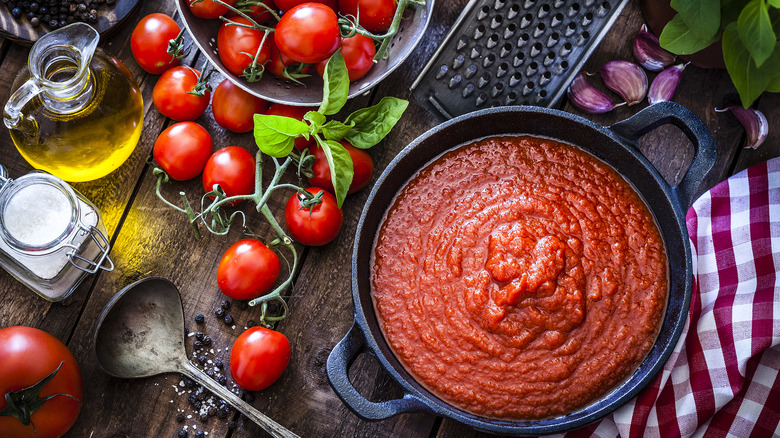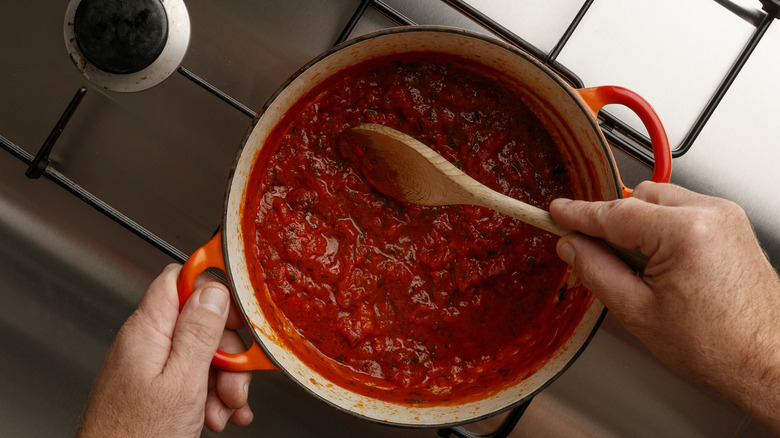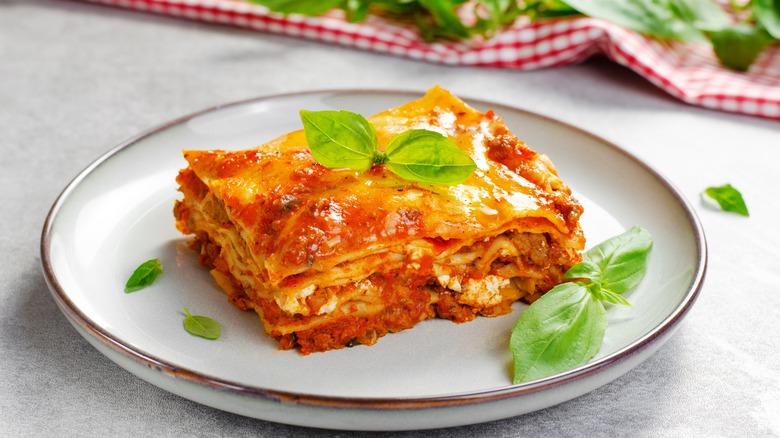Yes, There Is A Difference Between Marinara And Tomato Sauce
You might, as many home cooks do, use the terms marinara and tomato sauce interchangeably. You wouldn't be entirely amiss in doing so. After all, both have a tomato base and can be served as a part of many Italian dishes. And, to be fair, marinara does fall under the umbrella of tomato-based sauces. But did you know that the two are not, in fact, the same thing? There is actually a pretty big difference between these two sauces, and knowing what distinguishes one from the other can help you to better appreciate both.
Simply put, marinara is a simple, quick cooking sauce that uses a base of either canned or fresh tomatoes. According to Italian-American cookbook author Lidia Bastianich's website, marinara sauce should only be seasoned with a few very basic ingredients such as garlic, red pepper flakes, and basil. Marinara is typically pretty thin, allowing it to perfectly coat pasta or serve as a dipping sauce. In terms of taste, it leans heavily on tomato flavor and the few aromatic ingredients added to it.
Now, tomato sauce is a different matter entirely. According to Bastianich, tomato sauce is made of tomato puree and includes ingredients such as carrots, bay leaf, and (optionally) meat such as pork to add to its flavor. Tomato sauce is cooked until it is thick and sumptuous and is best used on heartier dishes, such as chicken parmigiana.
What separates marinara from tomato sauce
The difference between these two sauces is more complex than a small variation in texture and flavor, however. Though tomato sauce may seem like a catch all term for a tomato-based sauce, the term actually refers to a specific preparation of crushed tomatoes, or tomato puree. And you might be surprised about its origins. The sauce derives from one of the French mother sauces, which include hollandaise, espagnole, béchamel sauce, and velouté. The sauce was invented by French chef Auguste Escoffier who developed the recipe in the early 20th century, and this recipe is the basis for the more contemporary iterations of the sauce. However, the first recipe for tomato sauce (also known as sauce tomat), originally appeared in an Italian cookbook in 1692. The sauce often incorporates meat, animal fat or butter, and broth. Some recipes even call for a roux, which thickens the sauce.
Like tomato sauce, marinara was originally developed in the 16th century, after the Spanish introduced the tomato to Europe. Its name translates to "sailor's style", owing to the sauce's maritime origins. Marinara was often eaten by sailors at sea, a good move for those hoping to avoid scurvy, considering that tomatoes are high in vitamin C. The sauce has a much looser recipe, calling for tomatoes with a variety of aromatic ingredients and seasonings. The sauce does not include broth, meat, or roux, but tastes fresh and bright.
When to use marinara vs tomato sauce
Now that we know the difference between marinara and tomato sauce, we should consider how to best utilize both sauces. Because of the infusion of savory flavor brought by the addition of animal fat, meat, and stock, tomato sauce is much more savory than marinara sauce, which is bursting with pure tomato flavor. This, combined with tomato sauce's thick consistency, makes tomato sauce the perfect addition to hearty dishes, such as lasagna or even a nice shakshuka. Avoid using tomato sauce with pastas such as angel hair, as it might not hold up against your tomato sauce. Simply put, tomato sauce is a sturdy sauce that does best with structurally sound dishes tat can hold up to its taste and texture.
Marinara, on the other hand, is much lighter, with a fresh bite of tomato flavor. It also has a slight sweetness, thanks to its short cooking time and undiluted tomato base. These aspects make marinara a bright and delicious sauce that is perfect to pair with many dishes. A simple dish of marinara with pasta can be a perfect dinner, letting your sauce really shine. It also makes a great dipping sauce for calamari and mozzarella sticks. Both are delicious, of course, but you'll want to choose a dish that works best with their unique flavor profiles. With these facts in mind, you might want to try your hand at each and see how they compare.


